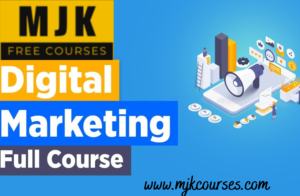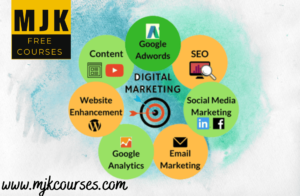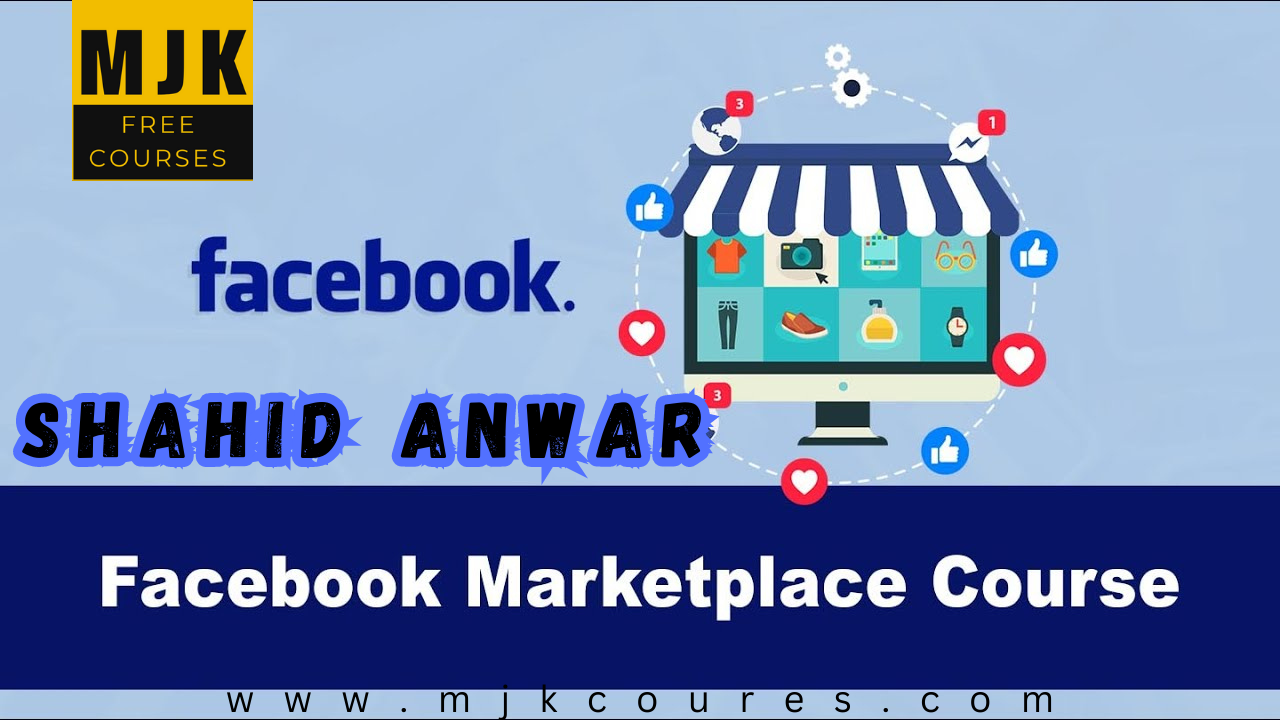
Digital Marketing – Digital Marketing Course
Table of Contents
ToggleCourse Title: Digital Marketing: Project-Based Learning
Course Description:
In this course, students will learn the principles and strategies of digital marketing and apply them to a real-world project. Through project-based learning, students will gain practical experience in creating and executing digital marketing campaigns that achieve measurable outcomes. This course is suitable for all types of learners who are interested in digital marketing and want to develop practical skills in this field.
Course Outcome:
Students will be able to do the following by the end of this course:
- Develop a comprehensive digital marketing strategy for a real-world project
- Design and execute digital marketing campaigns using various channels and tactics
- Analyze and optimize digital marketing performance to achieve business objectives
Project Plan:
The final project for this course will be to create a digital marketing campaign for a local business. Students will work in teams to develop a comprehensive strategy that includes goals, target audience, channels, content, and metrics. The campaign will be executed using various digital marketing tactics such as search engine optimization, social media marketing, email marketing, and paid advertising. At the end of the project, each team will present their campaign to the class and receive feedback from their peers and the instructor.
Module 1: Introduction to Digital Marketing
Lesson Plan:
- Learning Objectives:
- Define digital marketing and its benefits
- Identify the key components of a digital marketing strategy
- Real-World Examples:
- Successful digital marketing campaigns from different industries
- How digital marketing has transformed traditional marketing
- Activities:
- Brainstorm digital marketing goals and metrics for a local business
- Analyze a digital marketing case study and identify the key components of the strategy
- Discussion Questions:
- Why is digital marketing important for businesses today?
- How can a comprehensive digital marketing strategy help a business achieve its objectives?
- Video Script:
- “Welcome to Module 1 of Digital Marketing: Project-Based Learning. In this module, we will introduce you to the world of digital marketing and explain its benefits. We will also explore the key components of a digital marketing strategy and how they contribute to achieving business objectives. By the end of this module, you will have a clear understanding of the fundamentals of digital marketing.”
Module 2: Audience Analysis and Segmentation
Lesson Plan:
- Learning Objectives:
- Identify the target audience for a digital marketing campaign
- Segment the target audience based on demographics, psychographics, and behavior
- Real-World Examples:
- Different Approaches to audience segmentation in digital marketing
- The importance of understanding audience needs and preferences
- Activities:
- Conduct a survey to gather audience data for a local business
- Create buyer personas and customer journey maps for the target audience
- Discussion Questions:
- How can audience analysis and segmentation help a business create more effective digital marketing campaigns?
- What are some challenges of audience segmentation in digital marketing?
- Video Script:
- “Welcome to Module 2 of Digital Marketing: Project-Based Learning. In this module, we will explore the importance of audience analysis and segmentation in digital marketing. We will show you different approaches to audience segmentation and how to create buyer personas and customer journey maps. By the end of this module, you will have the skills to identify and target the right audience for your digital marketing campaign.”
Module 3: Content Strategy and Creation
Lesson Plan:
- Learning Objectives:
- Develop a content strategy for a digital marketing campaign
- Create engaging and relevant content for different digital channels
- Real-World Examples:
- Successful content marketing campaigns in different industries
- The Role of Storytelling in content creation
- Activities:
- Develop a content calendar
-
- Create different types of content such as blog posts, social media posts, videos, and infographics for a local business
- Optimize content for search engine ranking and user engagement
- Discussion Questions:
- How can content marketing help a business achieve its digital marketing goals?
- What are some best practices for creating engaging and effective content in digital marketing?
- Video Script:
- “Welcome to Digital Marketing: Project-Based Learning Module 3. In this module, we will dive into content strategy and creation for digital marketing campaigns. We will show you how to develop a content strategy that aligns with your business objectives and how to create different types of content for different digital channels. By the end of this module, you will have the skills to create engaging and relevant content that drives business results.”

Module 4: Social Media Marketing
Lesson Plan:
- Learning Objectives:
- Recognize social media’s role in digital marketing
- Develop a social media strategy for a digital marketing campaign
- Real-World Examples:
- Successful social media campaigns from different industries
- Social media use for businesses: advantages and challenges
- Activities:
- Conduct a social media audit for a local business
- Plan and schedule your social media content.
- Discussion Questions:
- How can social media help a business achieve its digital marketing goals?
- What are some best practices for using social media in digital marketing?
- Video Script:
- “Welcome to Digital Marketing: Project-Based Learning Module 4. In this module, we will focus on social media marketing and its role in digital marketing. We will show you how to develop a social media strategy that aligns with your business objectives and how to create engaging content for different social media platforms. By the end of this module, you will have the skills to use social media effectively to achieve your digital marketing goals.”
Module 5: Search Engine Marketing
Lesson Plan:
- Learning Objectives:
- Understand the basics of search engine marketing (SEM)
- Develop a search engine advertising strategy for a digital marketing campaign
- Real-World Examples:
- Successful search engine advertising campaigns from different industries
- The importance of keywords and targeting in SEM
- Activities:
- Conduct keyword research and analysis for a local business
- Create a search engine advertising campaign using Google Ads
- Discussion Questions:
- How can search engine advertising help a business achieve its digital marketing goals?
- What are some best practices for creating effective search engine advertising campaigns?
- Video Script:
- “Welcome to Module 5 of the Project-Based Learning for Digital Marketing course. In this module, we will explore the basics of search engine marketing (SEM) and how it can help businesses achieve their digital marketing goals. We will show you how to conduct keyword research and analysis and how to create search engine advertising campaigns using Google Ads. By the end of this module, you will have the skills to use SEM to drive traffic and conversions for your digital marketing campaign.”
Module 6: Performance Analysis and Optimization
Lesson Plan:
- Learning Objectives:
- Understand the importance of performance analysis in digital marketing
- Develop a measurement and optimization plan for a digital marketing campaign
- Real-World Examples:
- Different metrics and tools for measuring digital marketing performance
- The benefits of continuous improvement in digital marketing
- Activities:
- Analyze and interpret performance data for a local business
- Optimize digital marketing campaigns based on performance insights
- Discussion Questions:
- How can performance analysis and optimization help a business achieve its digital marketing goals?
- What are some best practices for measuring and optimizing digital marketing performance?
- Welcome to Module 6 of the Project-Based Learning in Digital Marketing course. In this module, we will focus on performance analysis and optimization in digital marketing. We will show you how to measure and interpret digital marketing performance using different metrics and tools, and how to use insights to optimize your campaigns for better results. By the end of this module, you will have the skills to continuously improve your digital marketing campaigns and achieve your business objectives.”

Project Plan: Real-World Application
For the final project of this course, you will apply the skills and knowledge learned in the course to create a comprehensive digital marketing campaign for a local business. The following elements will be included in the project:
- Business Analysis: Conduct a business analysis for a local business and identify its digital marketing objectives, target audience, and competition.
- Digital Marketing Strategy: Develop a digital marketing strategy that aligns with the business objectives and target audience. This should include a content strategy, social media strategy, search engine marketing strategy, and performance measurement plan.
- Content Creation: Create engaging and relevant content for the digital marketing campaign, including blog posts, social media posts, videos, and infographics.
- Social Media Marketing: Implement the social media strategy by creating and scheduling content for different social media platforms.
- Search Engine Marketing: Implement the search engine marketing strategy by creating and managing search engine advertising campaigns using Google Ads.
- Performance Analysis and Optimization: Continuously measure and analyze the performance of the digital marketing campaign using different metrics and tools, and optimize the campaigns based on insights.

A Comprehensive Guide to Increasing Your Online Presence for Digital Marketing
Introduction
The significance of digital marketing in the current digital era cannot be overstated. With the rise of the internet, businesses have been given an opportunity to reach out to their audience like never before. Digital marketing is a way to promote products and services using digital channels such as social media, email, search engines, and websites. In this blog, we will explore the basics of digital marketing and how it can help businesses achieve their marketing goals.
Section 1: What is Digital Marketing?
Digital marketing refers to any marketing efforts that use digital channels to promote products or services. Search engines, social media sites, email, and websites are some of these channels. The goal of digital marketing is to reach out to potential customers and engage them with relevant content that leads to conversions. Digital marketing is a way to reach a wider audience, build brand awareness, and drive sales.
Section 2: Why is Digital Marketing Important?
Digital marketing is important for businesses of all sizes. In today’s digital age, consumers are spending more time online, and businesses need to meet them where they are. Digital marketing allows businesses to reach out to their target audience in a cost-effective and measurable way. With digital marketing, businesses can:
- Reach a wider audience
- Build brand awareness
- Drive traffic to their website
- Generate leads and sales
- Measure and optimize their marketing efforts
Section 3: Digital Marketing Channels
There are several digital marketing channels that businesses can use to promote their products and services. These include:
- Search engine optimization (SEO)
- Pay-per-click advertising (PPC)
- Social media marketing
- Email marketing
- Content marketing
- Video Marketing
Each of these channels has its own unique benefits and can be used to reach different types of audiences. For example, social media marketing is great for reaching out to younger audiences, while email marketing is effective for nurturing leads and building customer relationships.
Section 4: Digital Marketing Strategy
A digital marketing strategy is a blueprint for how a company will use digital platforms to meet its marketing objectives. A good digital marketing strategy should include the following:
- Who is the campaign’s intended audience, exactly?
- Marketing objectives: What are the goals of the campaign?
- Budget: How much money will be allocated to the campaign?
- Digital channels: Which channels will be used to reach the target audience?
- Content plan: What type of content will be created for the campaign?
- Timeline: What is the timeline for the campaign?
- Measurement plan: How will the success of the campaign be measured?
Section 5: Digital Marketing Metrics
Digital marketing metrics are measurements used to track the performance of digital marketing campaigns. Some of the most common metrics used in digital marketing include:
- Traffic: the number of people who visit a landing page or website.
- Click-through rate (CTR): The percentage of people who click on a link or ad
- Conversion rate: The percentage of visitors who take the desired action.
- Cost per click (CPC): The cost of each click on an ad
- Return on investment (ROI): The revenue generated from a campaign compared to its cost
Section 6: Digital Marketing Tips
Here are some tips for businesses looking to improve their digital marketing efforts:
- Know your target audience and tailor your content to their needs and interests.
- Use a mix of digital channels to reach a wider audience.
- Create high-quality content that is engaging and informative.
- Use keywords and search engine optimization (SEO) to improve your website’s visibility in search engines.
- Use social media to build relationships with customers and engage with them in real-time.
- Measure and optimize your marketing efforts based on the metrics that matter most to your business.

Conclusion
Digital marketing is an effective way for businesses to reach out to their target audience and achieve their marketing goals. By using a mix of digital channels such as social media, email, search engines, and websites, businesses can build brand awareness, generate leads, and drive sales. With a well-defined digital marketing strategy, businesses can create engaging content tailored to their target audience and measure the success of their campaigns using key metrics.
In today’s competitive business landscape, it’s essential for businesses to have a strong online presence, and digital marketing is a powerful tool to achieve that. By following the tips outlined in this guide, businesses can improve their digital marketing efforts and reach a wider audience, build brand awareness, and drive sales. So, start implementing digital marketing strategies for your business today and see the results for yourself!
Search engine optimization (SEO)
Pay-per-click advertising (PPC)
Social media marketing
Email marketing
Content marketing Digital marketing encompasses a variety of channels, and each one plays a unique role in reaching and engaging with target audiences. In this article, we’ll take a closer look at six key components of digital marketing: search engine optimization (SEO), pay-per-click advertising (PPC), social media marketing, email marketing, content marketing, and video marketing.
Search Engine Optimization (SEO):
Search engine optimization (SEO) is the process of tweaking your website’s code and content to appear higher on search engine result pages (SERPs) for particular words and phrases. You can increase organic traffic to your website and brand recognition by increasing the visibility of your website in search results. Numerous strategies are used in SEO, including technical SEO, link building, on-page optimization, and keyword research.
Pay-Per-Click Advertising (PPC):
When a user clicks on one of an advertiser’s ads, they are paid for that click in a form of online advertising known as PPC. These ads can appear on search engine results pages, social media platforms, or other websites, and can be targeted based on demographics, location, interests, and other factors. PPC can be a highly effective way to drive targeted traffic to your website and generate leads and sales.
Social Media Marketing:
Social media marketing involves using social media platforms such as Facebook, Twitter, LinkedIn, and Instagram to promote your brand, engage with your audience, and drive traffic to your website. By creating and sharing content that resonates with your target audience, you can build brand awareness and increase engagement with your followers. Social media marketing also allows you to target specific demographics and interests to reach the right audience for your business.
Email Marketing:
Email marketing is the practice of promoting your brand and communicating with your audience via email. It can be used to share promotional offers, company news, and other updates with your subscribers. Email marketing can also be used to nurture leads and move them through the sales funnel. By creating targeted email campaigns and measuring their effectiveness, businesses can increase engagement and conversions.
Content Marketing:
In order to draw in and hold onto a clearly defined audience, content marketing entails producing and disseminating worthwhile, pertinent, and consistent content. This content can be presented in a variety of ways, including blogs, articles, infographics, videos, and more. By creating content that provides value to your target audience, you can establish your brand as a thought leader in your industry and drive traffic to your website.
Video Marketing:
To promote your business, goods, or services, you can use video marketing to produce and distribute video content. Video can be used to showcase product demos, customer testimonials, explainer videos, and more. Video marketing is highly engaging and can help businesses build brand awareness, increase engagement, and drive conversions.
In conclusion, digital marketing involves a mix of channels, each with its unique strengths and applications. By understanding the different components of digital marketing, businesses can create a comprehensive digital marketing strategy that reaches and engages their target audience and achieves their marketing goals.
ACCESS THE PAID COURSE FOR FREE


